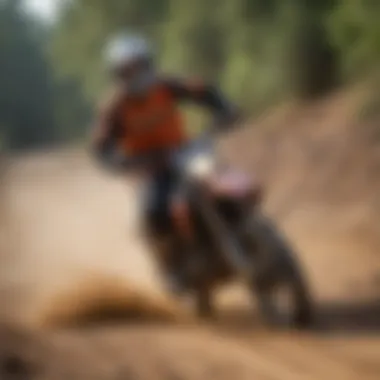Dirt Bikes on Roads: Legality, Safety, and Best Practices


Intro
Dirt bikes are often associated with off-road thrill-seeking adventures. However, the growing interest in using these versatile motorcycles on public roads raises important questions about legality, safety, and responsibility. Understanding the implications of riding dirt bikes on paved surfaces is essential for both new and experienced riders.
Many riders may not realize the various legal restrictions that exist. Different regions have specific requirements regarding modifications, registration, and insurance. Furthermore, there are safety considerations. Riding a dirt bike on the road can be risky due to its design, which is primarily tailored for uneven terrains. This article aims to delve into those aspects, providing informed insights for responsible riding.
Legality is a primary concern. Riders must know if their dirt bike complies with local laws for street usage. Many jurisdictions require certain modifications to make a dirt bike street-legal, which can include changes to tires, lighting, and exhaust systems.
Next, insurance plays a significant role in protecting riders and their investments. Not all standard motorcycle insurance policies extend to dirt bikes, especially when used on public roads. Therefore, understanding the specific coverage options available is critical.
The article will also touch on best practices for safe riding. Knowing how to ride defensively, understand your bike's capabilities, and ensure you are visible to other drivers is crucial for any rider operating on roads made for larger vehicles.
This comprehensive guide will equip you with the knowledge necessary to navigate the complexities of using dirt bikes on roads, ensuring you can enjoy the ride legally and safely.
Intro to Dirt Bikes and Road Use
The conversation surrounding dirt bikes and their use on roads is both timely and necessary. As interest in alternative modes of transportation grows, more riders are curious about the potential of dirt bikes outside their typical off-road environments. This article aims to shed light on this intersection, highlighting essential elements such as legality, safety, and modifications for road use. Understanding these aspects not only ensures compliance with various regulations but also enhances rider experience and safety.
The relevance of this discussion is underscored by an increase in road congestion and environmental concerns. Using dirt bikes addresses these issues while offering a unique riding experience. However, responsible riding and understanding the applicable laws are crucial for enjoyment and safety.
Defining Dirt Bikes
Dirt bikes are specifically designed motorcycles, optimized for off-road riding. They typically feature lightweight frames and powerful engines, allowing for agility on rough terrains. These motorcycles often come with knobby tires, long suspension travel, and minimal bodywork. Such characteristics help navigate obstacles typically encountered in natural environments, such as mud, rocks, and sand.
However, the design elements that make dirt bikes suitable for off-road conditions also pose challenges for road use. Riders must consider if their bikes can meet the necessary requirements for legal road operation.
The Popularity of Dirt Bikes
The growing interest in dirt bikes is notable, particularly among younger riders and outdoor enthusiasts. Several factors contribute to this trend. Firstly, dirt biking is often seen as an exhilarating adventure, providing an escape from everyday routines. The thrill of maneuvering across unpaved paths is attractive for many.
Secondly, dirt bikes can serve as a practical commuting option, especially in areas with short distances between key locations. Their compact size allows for easier navigation through traffic, contributing to their recent rise in road usage.
Moreover, as the motorcycle community expands, opportunities for engagement through organized events, social media platforms, and forums increase. Places like Reddit and Facebook host groups where riders share experiences, tips, and support. This social aspect fosters a sense of belonging within the community, encouraging new riders to join in the adventures of dirt biking.
In summary, dirt bikes present an opportunity for both thrill-seeking activities and practical transportation. As riding culture evolves, understanding the implications of road usage becomes increasingly important for riders.
Legal Considerations
Legal considerations are essential when it comes to dirt bikes and their usage on roads. Understanding these laws is crucial for avoiding legal complications and ensuring safe riding experiences. Each state has its own set of regulations governing the use of dirt bikes. Violating these rules can lead to fines, confiscation of bikes, or other legal repercussions. Therefore, being informed about specific laws is not just a benefit but a necessity.
State Regulations on Dirt Bike Usage
State regulations dictate where dirt bikes can be legally operated. In many places, dirt bikes are not permitted on public roads unless they meet specific criteria for road compliance. For example, some states require that dirt bikes be converted to meet highway standards, including certain equipment and safety features.
Riders should familiarize themselves with the laws of their state or locality. Some common regulations include:
- Legal Age Requirements: Different states have minimum age restrictions for riding.
- Noise Ordinances: Many regions have noise regulations that specific dirt bikes may exceed.
- Designated Areas: Some states designate certain tracks or areas where dirt bikes can be operated legally.
Ignoring these regulations can result in serious consequences, not to mention a safety hazard for the rider and others. Therefore, ensure you have the correct information before venturing out on the streets.
Licensing and Registration Requirements
Licensing and registration are integral elements to consider, as they directly impact a dirt bike rider's legal standing. A valid motorcycle license, or special endorsement for dirt bikes, may be required in certain states. Moreover, the registration of the bike itself is essential for compliance.


Here are key points to reflect on:
- License: Check if your state requires a motorcycle endorsement for dirt bikes.
- Registration: Most states mandate that dirt bikes be registered with the local Department of Motor Vehicles (DMV).
- Title: Ensure that you have the bike's title, proving ownership and simplifying future processes.
Every rider should take the time to verify requirements in their area. Failing to comply can lead to penalties, affecting riding experiences.
Insurance Implications for Road Use
Insurance is often overlooked but is critical when using dirt bikes on the road. Without adequate coverage, riders expose themselves to significant financial risks in case of accidents, theft, or damage. Insurance requirements can vary by state and insurer but typically focus on:
- Liability Coverage: This is the most basic type of insurance. It covers damages to others if you are at fault in an accident.
- Comprehensive Coverage: This option can help cover damages from incidents not involving collisions, such as theft or weather-related damage.
- Uninsured/Underinsured Motorist Coverage: This provides protection if you are involved in an accident with someone who lacks sufficient insurance.
"Riders should not only think of insurance as a requirement but as a safeguard against unexpected events while riding on roads."
Safety Considerations
Safety considerations are crucial when discussing dirt bikes and their use on public roads. Riders must be aware that these vehicles are not only designed for off-road activities but are also subjected to road traffic laws. Proper attention to safety can prevent a lot of potential accidents and injuries, making it vital to understand the necessary precautions involved.
Protective Gear for Riders
Proper protective gear is essential for any dirt bike rider intending to use their bike on the road. Unlike casual cycling, riding a dirt bike presents various risks that can lead to serious injuries. Riders should invest in high-quality equipment to enhance their safety.
Some recommended gear includes:
- Helmet: A DOT-approved helmet is critical. It protects the head in case of accidents, reducing the severity of head injuries.
- Jackets and Pants: Abrasion-resistant jackets and pants provide necessary protection from scrapes and impacts. Look for gear specifically designed for motorcycling, as it will offer better protection than standard clothing.
- Gloves: Gloves improve grip on the handles, protecting hands from blisters and impacts.
- Boots: Sturdy riding boots should provide ankle support and protect the feet. They should also have non-slip soles to help maintain traction.
By wearing appropriate protective gear, riders significantly decrease their chances of serious injury in the event of an accident.
Road Safety Tips for Dirt Bike Riders
Riding a dirt bike on public roads requires a specific awareness of road conditions and traffic rules. Here are some road safety tips:
- Stay Visible: Always wear bright or reflective clothing. Ensure that your bike’s lights are functioning properly to make yourself visible to other drivers.
- Follow Traffic Signals: Adhere to all traffic signs and signals as you would in a car. This is vital for your safety and that of others.
- Maintain a Safe Speed: Speed is a major factor in accidents. Maintaining a speed appropriate for road conditions can prevent a loss of control.
- Use Signals: Always use hand signals to indicate turns or stops. This openness to communication with other road users can prevent misunderstandings.
- Watch for Hazards: Stay alert for obstacles, potholes, or any debris on the road that could cause accidents. Dirt bikes have a higher risk of skidding on loose surfaces or encountering sudden obstacles.
Common Risks Associated with Dirt Bikes on Roads
While dirt bikes are thrilling and adventurous, riding them on public streets is not without risk. Several common risks include:
- Lack of Stability: Dirt bikes are generally lightweight and designed for off-road terrains. This makes them less stable on asphalt compared to standard motorcycles. The possibility of tipping over increases on uneven surfaces.
- Falling Off the Bike: Due to higher speeds and the nature of dirt bike riding, falling off is a common issue that can lead to serious injuries.
- Inexperienced Riders: Novice riders might not be fully prepared for the unique challenges of road riding. It's crucial to have adequate training and practice before heading onto busy streets.
"Understanding and respecting safety can save lives. This applies to new and experienced riders alike."
Ensuring safety is not only beneficial to the rider but also to other road users. By recognizing the risks and actively implementing safety measures, riders can enjoy their dirt bikes on the road while minimizing dangers.
Modifications for Street Legality
To navigate the complexities of dirt bike usage on paved roads, modifications ensuring street legality are vital. These adjustments not only comply with legal standards but also enhance rider safety. Some riders may underestimate these aspects, but without proper modifications, their riding experience can lead to legal ramifications and potential hazards.
Dirt bikes are designed for off-road conditions, so adapting them for road usage requires careful consideration of various factors such as safety features, performance, and compliance with local regulations. Achieving legality opens up new opportunities for riders, allowing them to explore both off-road trails and urban environments without fear of penalties.
Essential Upgrades for Compliance
Lighting Modifications
Lighting modifications are essential for any dirt bike converting to street use. Standard dirt bikes often lack adequate lighting required by road regulations.
A key characteristic is the installation of front and rear lights including headlights, brake lights, and turn signals. This ensures visibility during both day and night, providing safety for the rider and other road users.


The unique feature of these upgrades is the potential to improve road safety significantly. A properly lit bike enhances visibility, which can reduce the chances of accidents. However, there can be disadvantages, such as increased maintenance needs for the lights and potential electrical system overloads if not installed properly.
Exhaust System Changes
Exhaust system changes play a crucial role in ensuring that the dirt bike meets noise regulations. Many areas impose strict limits on noise levels for vehicles on public roads. Hence, altering the exhaust system is necessary to comply with these rules.
The prominent aspect of this modification is that it can lead to lower noise output. This is beneficial as it reduces disturbances in residential areas and typically increases the rider's legal compliance. The disadvantage, however, might be a potential decrease in power output if the system is not adjusted correctly. Riders must weigh these factors when considering changes.
Tires and Brakes Adaptation
Tires and brakes adaptation is another significant modification for road legality. Dirt bike tires are not designed for the pavement. Choosing suitable tires improves grip, control, and safety on road surfaces. Likewise, brakes need enhancement to accommodate higher speeds and stop more effectively on asphalt, a drastic difference from dirt paths.
The adaptability of tires and brakes is crucial; dirt tires can slide on wet pavement, leading to dangerous situations. Changing to road-appropriate tires can reduce these risks and enhance overall riding experience. However, the downside is that these modifications may increase the bike's purchase price and maintenance complexity.
Choosing the Right Dirt Bike for Conversion
Selecting the right dirt bike for conversion into a street-legal machine is paramount. Factors to consider include the bike's engine size, weight, and inherent capabilities. Some bikes lend themselves better to road modifications than others, given their original design and components. A proper understanding of these elements can guide any potential buyer toward making the best decision for dual-purpose use.
Insurance Insights
The importance of insurance insights in the context of dirt bikes cannot be overstated. As riders consider taking their dirt bikes on public roads, understanding how insurance policies operate is crucial. Accidents can happen unexpectedly, and without proper coverage, both financial and legal repercussions may arise. This section will delve into the fundamental aspects of dirt bike insurance, its implications on premiums when riding on roads, and best practices for obtaining suitable coverage.
Understanding Dirt Bike Insurance Policies
Dirt bike insurance policies vary significantly from standard motorcycle insurance. These policies are tailored to cover the unique risks associated with dirt bike riding, especially when the vehicle is used on public roads. Key elements of these insurance policies include:
- Liability Coverage: This protects riders from costs associated with injuries or damages caused to others in a collision.
- Comprehensive and Collision Coverage: Comprehensive plans shield against non-collision-related damages, while collision coverage takes care of costs related to bike accidents.
- Uninsured/Underinsured Motorist Coverage: This is crucial for scenarios involving other drivers who do not carry adequate insurance.
Understanding these components provides riders with a clearer picture of what coverage they might need. Additionally, they must ensure that the policy meets local regulations and is suitable for road usage.
How Riding on Roads Affects Insurance Premiums
Riding a dirt bike on public roads often leads to adjustments in insurance premiums. The risks increase due to higher traffic exposure and potential interactions with various vehicles. Factors influencing these changes include:
- Increased Risk Assessment: Insurers assess the likelihood of accidents differently when the bike is used on roads. Consequently, premiums could rise.
- Type of Use: If the dirt bike is primarily used off-road but is also registered for road use, this may affect the baseline premium calculations.
- Rider Experience: An experienced rider may face lower premiums compared to a novice, as insurers often consider the rider’s track record.
In summary, riders must be cautious and proactive when shifting their riding habits from trails to roads, as this shift significantly impacts insurance costs.
Best Practices for Insuring Your Dirt Bike
To ensure comprehensive coverage while minimizing insurance costs, riders should adopt several best practices:
- Shop Around: Different insurers offer various packages. Comparing quotes can lead to better options and prices.
- Bundle Policies: Consider bundling dirt bike insurance with other policies, such as home or auto insurance, to receive discounts.
- Review and Update Coverage Regularly: Changes in usage, such as using a dirt bike more frequently on the road, necessitate reassessing the insurance.
- Maintain a Clean Riding Record: Safe riding habits contribute to lower premiums. Avoiding accidents and traffic violations is vital.
"Insurance is not just about protection; it is about peace of mind."
By implementing these practices, riders can ensure they have adequate protection without unnecessary financial strain.
Environmental Considerations
Understanding the environmental impact of dirt bikes on roads is crucial for several reasons. As dirt bikes transition from trails to pavement, they introduce unique challenges that can affect the surrounding environment. These factors can range from infrastructure wear to ecological disturbances. Addressing these concerns is vital not only for sustaining road quality but also for ensuring the natural habitats remain intact. It is essential to consider the long-term sustainability of using dirt bikes on paved surfaces and how responsible riding practices can mitigate negative effects.
Impact of Dirt Bikes on Road Infrastructure
Dirt bikes can significantly influence road infrastructure. The lightweight nature of dirt bikes may seem harmless, but their concentrated tire pressure can lead to unwanted wear on the pavement. Frequent and prolonged use can cause cracks and surface degradation, leading to costly repairs. Additionally, dirt bike riders often use areas that are not typically designed for such vehicles, causing erosion and altering the terrain.


It's crucial for local governments and riders to recognize these impacts and proactively address them. For example, implementing designated dirt bike paths can alleviate pressure on regular road surfaces and help preserve infrastructure. By taking such steps, communities can maintain both road quality and rider safety.
Mitigating Environmental Damage
Responsible Riding Practices
Adopting responsible riding practices plays a significant role in minimizing environmental damage caused by dirt bikes on roads. By following guidelines such as staying on designated paths, riders can reduce their footprint. One key characteristic of responsible riding is respecting closed or sensitive areas. This approach not only protects natural habitats but also promotes a positive image of dirt bikers within local communities.
Furthermore, riders should maintain their bikes regularly to ensure efficient operation. Well-maintained bikes have lower emissions and are safer to ride. The unique feature of responsible riding is its emphasis on collective accountability among riders. When the dirt bike community embraces these practices, it builds a culture that prioritizes environmental stewardship.
Adoption of Eco-Friendly Technologies
The adoption of eco-friendly technologies represents another way to mitigate environmental damage. As manufacturers develop greener models, dirt bikers can choose options with lower emissions. The key characteristic of these technologies is their efficiency, resulting in reduced air pollution and noise. Manufacturers like Yamaha and Honda are introducing electric dirt bikes that cater to environmentally conscious consumers.
Implementing these technologies can be seen as a beneficial choice for the dirt bike community. Not only do electric models provide a quieter ride, but they also lessen the ecological impact associated with fuel-based alternatives. The unique feature of eco-friendly technologies lies in their dual ability to enhance rider experience while contributing to environmental health.
Community and Culture
The topic of Community and Culture holds a significant position in the conversation about using dirt bikes on roads. This section examines how communal connections and cultural practices can enhance the experience for riders. Understanding the influence of community not only supports the growth of responsible riding but also fosters a sense of belonging among enthusiasts.
Dirt Bike Community Engagement
Engaging with the dirt bike community offers various benefits. First, it creates networking opportunities among riders of all skill levels. Engaging in discussions within online platforms such as Reddit or Facebook helps riders share insights and experiences. These platforms can also be vital for educating new riders about the laws and safety practices regarding on-road use.
Additionally, active community engagement promotes a culture of responsibility. Riders who connect with others are more likely to adhere to safety guidelines and share best practices. They exchange tips on maintenance and the necessary upgrades for making dirt bikes road-compliant. This exchange not only enhances personal knowledge but also strengthens the integrity of the riding community as a whole.
Moreover, involvement in community activities allows for social bonding. It also provides chances to influence local policies about dirt bikes on roads.
Organized Events for Road Riders
Organized events play a crucial role in shaping the culture surrounding road riding on dirt bikes. These events often include group rides, races, and safety workshops. Such gatherings foster camaraderie among riders and provide hands-on opportunities to learn and share knowledge.
Participating in organized events allows riders to experience different terrains and road conditions in a safer environment. They also create a platform to showcase changes in laws or improve awareness about best riding practices among participants.
"A vibrant community can cultivate a more responsible culture of bike riding among users."
Additionally, events can help raise funds for local charities or community projects. Riders coming together for a shared cause can enhance public perception of dirt biking. The sense of community derived from such initiatives can also support the growth of local track or recreational areas, benefiting both current and future riders.
Engaging in this community aspect is not only essential for personal growth as a rider but also vital for ensuring the future viability of the sport and its acceptance in broader society.
Finale
The topic of using dirt bikes on roads is increasingly relevant as more riders seek alternative ways to enjoy their vehicles beyond off-road trails. Understanding this intersection is vital for a variety of reasons. First, knowledge of legal requirements ensures that riders operate within the law, reducing the risk of citations or penalties. Additionally, safety considerations are paramount. Riders must be equipped with the appropriate gear to protect themselves on varied terrains, especially on roadways where the stakes can be higher.
The modifications necessary for compliance not only enhance the legal status of a dirt bike but also improve its performance on paved surfaces, which leads to a safer riding experience. Riders can enjoy the freedom offered by dirt bikes while being mindful of their responsibilities, both to themselves and their communities.
Furthermore, engaging with the dirt bike community fosters a culture of sharing best practices and promoting responsible behaviors. This can ultimately lead to better relationships with local governments and other road users. Overall, the harmonization of dirt bikes with road use presents both opportunities and challenges for riders, manufacturers, and legislators alike.
Summary of Key Points
- Legal Requirements: Familiarize yourself with state regulations regarding dirt bike usage on public roads to avoid potential legal issues.
- Safety Practices: Invest in high-quality protective gear and follow road safety guidelines, as these can significantly lower the risk of injury.
- Modifications: Be aware that certain modifications are necessary for compliance with road use laws, such as upgrading lighting systems and enhancing exhausts.
- Insurance Considerations: Understand how riding on roads can affect your insurance premiums and explore policies specifically designed for dirt bikes.
- Environmental Awareness: Recognize the impact of dirt bike usage on infrastructure and commit to responsible riding practices that mitigate these effects.
Future of Dirt Bikes on Roads
The landscape for dirt bikes on roads is evolving. As urban areas expand and trails become less accessible, there may be an increased demand for street-legal dirt bikes. Manufacturers may respond with models designed specifically for this dual purpose, integrating features that allow for smooth transitions from off-road to on-road environments.
Legislators may also revisit laws and regulations to accommodate this growing trend. Striking a balance between recreational use and public safety will be essential. Collaborations between dirt bike communities and local governments can promote safety and environmental initiatives, enhancing the overall perception of dirt biking as a responsible and enjoyable activity.
In this light, the future holds potential for innovation in the dirt bike sector, with eco-friendly technologies perhaps leading the way. The harmonious integration of dirt bikes into everyday traffic can create new social and recreational opportunities for riders, making it an exciting time for the dirt biking community.
Riding dirt bikes on roads is more than just a trend; it’s an evolving culture that reflects lifestyle choices and environmental considerations.



